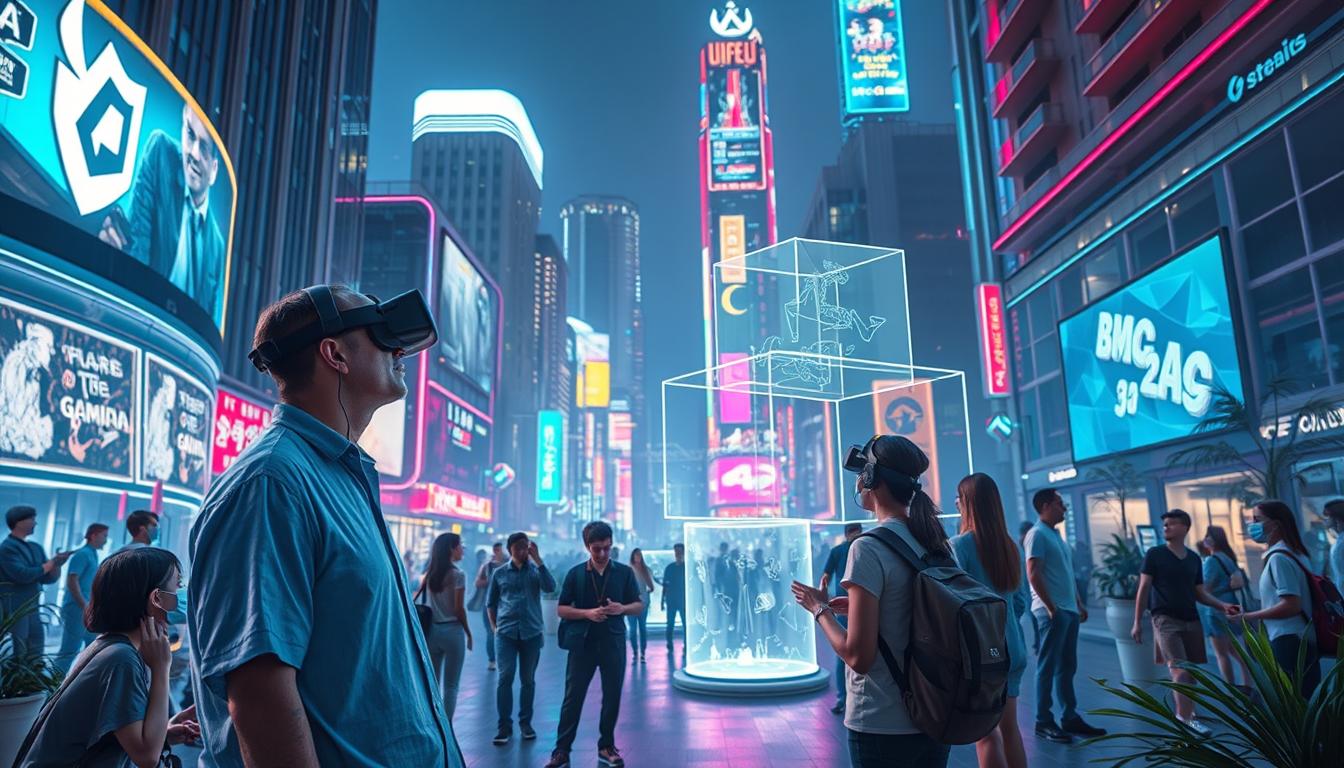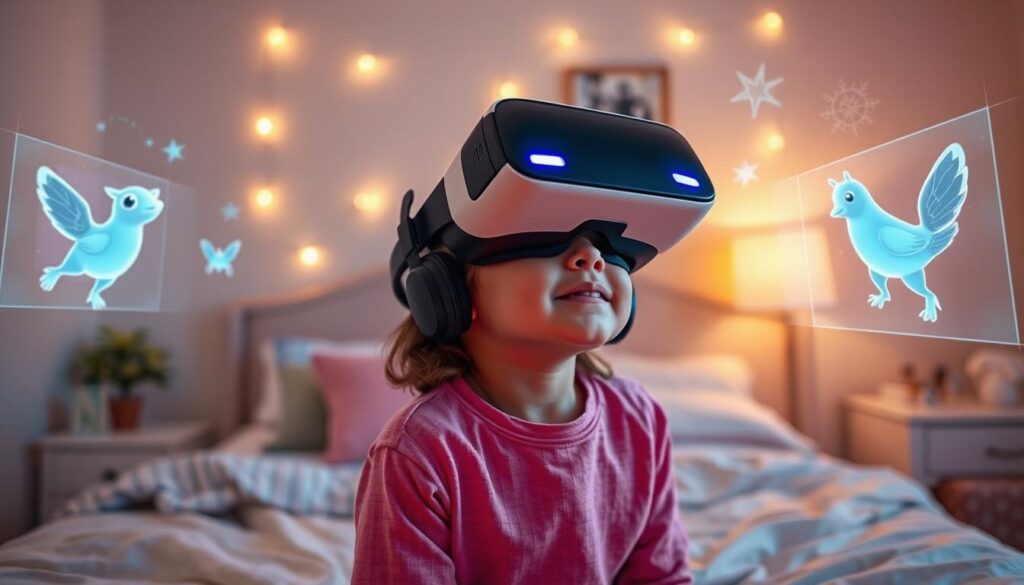“The future is already here – it’s just not evenly distributed.” – William Gibson, science fiction author
William Gibson’s words capture the fast-changing world of virtual reality (VR) and augmented reality (AR). As we approach 2024, these technologies are set to change many industries. They will also change how we work and play, and how we interact with computers.
VR and AR are bringing new ways to enjoy entertainment and learn. They are part of a new era of spatial computing and extended reality (XR).
Experts say the AR market will grow fast, reaching over $300 billion by the 2030s. By 2024, 1.7 billion people will use mobile AR, with Android leading the way.
Key Takeaways
- The AR market is predicted to grow exponentially, reaching over $300 billion by the 2030s.
- Mobile AR is expected to have 1.7 billion users worldwide by 2024, with Android leading the charge.
- VR and AR technologies are revolutionizing training and education, with VR learners absorbing knowledge four times faster than classroom learners.
- Immersive experiences, including mixed reality retail and virtual learning environments, are set to become more prevalent in 2024.
- The immersive internet will incorporate cutting-edge technologies like generative AI, multi-sensory experiences, and blended virtual environments.
The Present and Future of AR Technology
Augmented reality (AR) has moved from the experimental stage to the mainstream. It’s now key for brands and businesses to grasp its value. The AR market is set to grow from $32.1 billion in 2022 to over $300 billion by the 2030s. Advances in mobile device hardware and wearable AR headsets make it easier to bring AR products to market.
Navigating the AR Landscape
Nearly 70% of those surveyed by Jabil think AR/VR will become mainstream in five years. This shows growing demand and acceptance. With many households having multiple smartphones, tablets, and desktops, AR can easily become part of our daily lives.
Advancements in Mobile AR Hardware
The first real smartphone was launched over a decade ago, changing our lives. Pokémon Go, an AR app, showed mass adoption in 2016. Virtual reality experiences, delivered through smartphones and headsets, are now common. As mobile hardware evolves, AR technology will offer more immersive experiences.
“AR is an emerging technology with a focus on education and learning applications.”
Artificial Intelligence Powers AR Technologies
Artificial Intelligence (AI) has changed the game for Augmented Reality (AR) tech. It brings new features like object and surface recognition, human scanning, and text translation. For example, Apple’s Vision Pro uses AI to scan faces for smooth FaceTime calls.
AI Applications in AR
AI and AR are teaming up for new solutions. Researchers have made a device setup app that uses AI and AR. It guides users and fixes problems with computer vision and natural language processing.
The Future of Generative AI in AR
Generative AI is set to change AR even more. It can make 3D objects, textures, and animations fast. This means we’ll see more dynamic and personal AR experiences soon.
“The synergy between AI and AR is unlocking a world of possibilities, from intelligent device setup to the creation of truly captivating virtual worlds.”
Mobile Augmented Reality Expands Beyond Gaming
Mobile AR is no longer just for games and fun. It’s now being used in many business areas. Thanks to Google’s ARCore and Apple’s ARKit, professionals and companies can use augmented reality in new ways.
ARCore Updates: Flashlight Support and Places API Integration
Google’s ARCore has gotten better, adding features for work. Now, AR can work in dark places thanks to flashlight support. The Places API also lets you add real-world info, like business details, to AR scenes.
ARKit 6 Enhancements: 4K Video, Location Anchors, and More
Apple’s ARKit 6 has cool new features for mobile AR. You can now record 4K videos in AR, great for virtual tours and product demos. Plus, better location anchors mean AR can be more precise and useful for businesses.
Mobile AR is growing, moving beyond just games. Businesses are using it to improve their work, make things more efficient, and give customers better experiences.
ARCore vs ARKit in 2024
The battle between Google’s ARCore and Apple’s ARKit is heating up. Both platforms offer great features, but the device’s hardware can change the game. This affects how users enjoy augmented reality.
Hardware Limitations and User Experience
ARCore works on many Android devices, starting from Android 7.0 Nougat. This means more people can try AR experiences. But, different Android devices can make AR performance vary.
ARKit, on the other hand, is made just for iOS devices. This focus lets Apple fine-tune AR for its products. So, users get a better AR experience on compatible devices.
| Feature | ARCore | ARKit |
|---|---|---|
| Motion Tracking | ✓ | ✓ |
| Scene Understanding | ✓ | ✓ |
| Lighting Estimation | ✓ | ✓ |
| Augmented Images | ✓ | ✓ |
| Device Compatibility | Wide range of Android devices | Exclusive to iOS devices |
When picking ARCore or ARKit, developers must think about device limits and user experience. Making apps work well on various devices ensures a great AR experience for everyone.
5G Connectivity Unlocks New Possibilities for Mobile AR
The arrival of 5G technology has brought new possibilities for mobile augmented reality (AR). It offers fast data speeds and low latency. This is changing how we interact with digital surroundings.
5G’s main benefit for mobile AR is its ability to work well with cloud-based resources. Unlike older networks, 5G’s fast connection and low lag let AR apps use the cloud for complex tasks. This makes AR experiences more immersive and responsive.
| Metric | Improvement with 5G |
|---|---|
| Data Transfer Speed | Up to 20Gbps, 100 times faster than 4G |
| Latency | Sub-5 or sub-2 milliseconds, a 10X decrease from 4G |
| Minimum Acceptable Latency for VR | 5G’s low latency eliminates the nausea-inducing lag experienced in previous VR systems |
5G’s improved features are set to boost mobile AR use in many fields. From AR in outdoor navigation to AR in industrial training, the possibilities are vast. Intel predicts that by 2028, AR games will make up over 90% of 5G AR revenue, reaching around $36 billion worldwide.
“5G technology is anticipated to enable a rapid adoption of VR, AR, and immersive cloud-connected experiences due to its support for faster data rates, lower latency, and reduced cost per bit.”
As 5G networks grow, mobile AR will become a big part of our lives. It will change how we interact with both digital and physical worlds.
WebAR: Building More Accessible Experiences
The digital world is always changing, and making augmented reality (AR) technology accessible is key. WebAR experiences can be a great option for reaching more people. 8th Wall’s Niantic Studio has introduced Gaussian splatting for creating realistic 3D environments in WebAR. This lets users enjoy AR without needing to download an app.
8th Wall’s Niantic Studio and Gaussian Splatting
8th Wall’s Niantic Studio is leading the way in making WebAR more accessible. With Gaussian splatting, it makes 3D environments look real and feel immersive. This means users can dive into AR content easily, without needing special hardware or apps.
WebAR isn’t just about making things easier to access. It also makes it simpler for creators to make engaging experiences. This means more people can enjoy AR content on different devices and platforms. It’s a big win for businesses and individuals looking to connect with their audience in new ways.
| Feature | Benefit |
|---|---|
| Gaussian Splatting | Allows for the creation of more realistic 3D environments in WebAR |
| Browser-Based Access | Eliminates the need for dedicated app installation, improving accessibility |
| Cross-Platform Compatibility | Enables the deployment of AR experiences across various devices and operating systems |
| Simplified Development | Web frameworks abstract low-level programming complexities, making it easier for developers to create AR experiences |
As WebAR technology grows, it promises to make AR more accessible and reach more people. This opens up new ways for businesses and individuals to connect with their audience through immersive experiences.
VR, AR Innovation: Cross-Platform Augmented Reality Applications
The augmented reality (AR) market is growing fast. Targeting both Android and iOS with cross-platform AR apps is key. This way, companies can reach more people and meet different needs.
Android leads the mobile OS market with over 70% share. But, iOS users spend more, offering a big chance for businesses. Cross-platform apps make AR experiences available to more people, boosting engagement.
Reaching Wider Audiences with Cross-Platform Apps
Developing Cross-Platform AR apps helps companies:
- Grow their Audience Reach by serving both Android and iOS users.
- Use each platform’s special features to make engaging AR experiences.
- Make their AR innovations available to a wide range of users, no matter their device choice.
- Keep up with local market trends and demographics, where Android and iOS shares differ.
- Get a better return on investment (ROI) by reaching more people and increasing AR adoption.
By going for Cross-Platform AR development, companies can stay ahead. They can offer innovative, easy-to-use experiences that grab users’ attention across the mobile world.
User Safety in AR/VR: Protecting Kids and Teens
Augmented and virtual reality (AR/VR) are becoming more popular. It’s important to keep kids and teens safe while they enjoy these new experiences. Everyone needs to work together to make sure these technologies are safe and fun for young people.
Keeping the privacy and security of young users is a big challenge. Many teens play VR games and own AR/VR devices. It’s clear that these technologies are becoming a big part of their lives.
Balancing Safety and Innovation
Teenagers often start using more technology as they get older. Many kids want to try VR, and some already own headsets. This makes us worry about their safety.
As AR/VR gets better, we need to make sure it’s safe for kids and teens. Developers, policymakers, and parents must work together. They need to create strong safety measures and make sure the content is right for their age.
| Statistic | Value |
|---|---|
| About half of U.S. teens have played a game in VR | 50% |
| Nearly one in three teens own an AR/VR device | 33% |
| 70 percent of children ages 8–17 are interested in experiencing VR | 70% |
| 17 percent of children report owning a VR headset | 17% |
We need to find a good balance to keep kids and teens safe in AR/VR. Developers, policymakers, and parents must work together. They should create strong safety measures and make sure the content is right for their age. This way, young users can enjoy these exciting technologies safely.
Generative AI’s Impact on Virtual Worlds and the Metaverse
The use of Generative AI is changing virtual worlds and the metaverse a lot. Tools like Spline let people make 3D objects, textures, and animations with just words. This is making it easier to create content for digital worlds.
The metaverse is becoming more popular, and Generative AI is key to its future. Generative AI can make real-looking images, videos, text, and 3D models for VR and the Metaverse. This makes building virtual worlds easier and more fun.
In 2024, AI-driven systems will make VR stories that change based on what you do. You can also make and sell your own virtual items in the Metaverse with AI-powered design tools. Generative AI will help figure out the best prices for virtual goods and services.
2024 will see AI-generated avatars, new ways to build worlds, AI-enhanced interactions, virtual tours, and more. As Generative AI gets better, we’ll see even more realistic virtual worlds and stories. This will make our experiences in the Metaverse even more real.
“Generative AI solutions significantly enrich the creation of content within the metaverse by automatically developing vast and complicated virtual environments and detailed assets.”
Adding Generative AI to the Metaverse and virtual worlds is a big deal. It’s changing how we interact, create, and enjoy digital spaces. It’s opening up new areas for creativity and discovery.
The AR/VR Technology Behind Immersive Experiences
The world of augmented reality (AR) and virtual reality (VR) uses amazing technologies. These include high-resolution displays, advanced camera systems, and strong wireless connections. These parts are key to creating the most engaging and interactive experiences.
Display Technology
At the center of AR and VR headsets are displays that show 3D images clearly. These displays must show sharp, high-definition visuals. They need to blend well with the real world or create a full virtual world.
Improvements in display tech, like better resolution and faster refresh rates, are vital. They help make the experience truly captivating.
Cameras and Sensors
For AR and VR, tracking and navigation are crucial. Time-of-flight cameras, standard 2D cameras, and motion sensors help with this. They allow for accurate tracking of objects and the environment.
These camera systems and sensor arrays are key for recognizing objects, tracking hands, and mapping environments. They’re essential for creating interactive and immersive experiences.
Wireless Connectivity
Wireless connectivity is vital for the future of AR and VR. Wi-Fi and Bluetooth help send live video, 3D content, and data between devices and the cloud. This wireless connection is key for free movement and interaction with digital content.
As AR/VR technology grows, so will these core components. They will help make experiences more immersive, interactive, and accessible in many fields.
Conclusion
The world of VR and AR is changing fast. New technologies and apps in 2024 will change many industries. They will also change how we interact with computers and the world around us.
AI-powered AR solutions and cross-platform experiences are leading the way. Advances in hardware are making these technologies even better. This means we’ll see new ways to work, play, and learn.
VR and AR are making a big impact in many areas. This includes gaming, education, healthcare, and entertainment. Virtual Reality lets us dive into virtual worlds. Augmented Reality mixes digital info with our real world.
New tech like haptic feedback and eye-tracking is making things even better. These advancements make VR and AR more natural and fun to use.
As VR and AR grow, we must think about safety, access, and innovation. We need to solve problems like privacy and misuse. If we use these technologies wisely, they can change our future in big ways.















